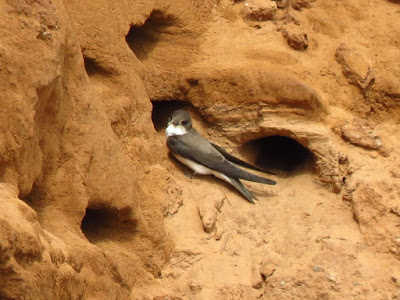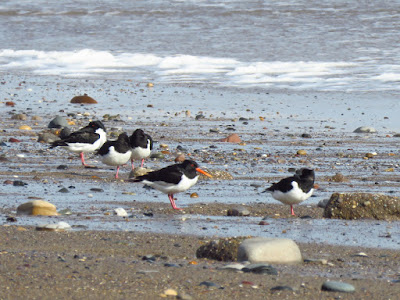
After wondering if it was worth carrying on with the Migrants Way given that, due to the lockdown, I had missed almost two months of spring migration, I decided to continue. It is not a long drive to the Holderness coast and social isolation is not a problem. I had counted on no walks during the Easter break anyway so it should be relatively easy to catch up.
There were showers as I left home, but once at Homlpton, it had stopped raining. It was a warm, calm morning, with brief sunny spells. I parked on Seaside Road at Holmpton and took in the bird song, and the lushness of the vegetation in the village, before taking the coastal path north.
Fishermen and a fisherwoman at work.
Although some fields are tilled and sown to the edge of the cliff, there are long stretches with a wide fringe of rough, uncultivated land by the coastal path from Holmpton to Withernsea. This is a haven for a range of farmland birds. Flocks of Linnets twitted by, Skylarks rose and sung, Meadow Pipits did their parachute flights, one with insects in its bill, feeding young. Hirundines were also a plenty, especially Sand Martins, and there are occasional pairs or quartets of Swifts flying north.I cross the Runnel, a small drain with a collapsed pillbox. I pass a few farms.
A Swallow singing at Holmpton.
Reed Bunting
Linnet singing.
A well marked male Linnet.
Meadow Pipit.
Horses at Nevilles Farm.
Camouflaged skylark.
At Intack farm, I have to move to the road as the clifftop path south of Withernsea, by the caravan parks, is not accessible due to coastal erosion and coastal defence works. As I get to the road, I hear a familiar jingle of keys, a Corn Bunting, singing from a wire.
Other than the stretch beyond the promenade, there are a few ways down the cliff to the beach which frequented by fishermen, but only the one by The Runnel is easily accessible. The others are steep steps made on the clay, some supported with slabs of concrete.As I reach the edge of Withernsea, I hear House Sparrow's sparrowhawk call, when I look up, there is a Sparrowhawk indeed, but mobbing a Red Kite, which is something I wasn't expecting!
Red Kite.
Fishing for bait?
Looking back: a view of Dimlington Cliffs and Out Newton farm.
Herring Hulls on nests at Withernsea.
Pied Wagtail on sea wall.
This male House Sparrow flew to the sea defences and collected a bill full of insects in no time at all.
I walk by the south promenade until the end of the stage at the Withernsea Pier towers (also called Withernsea Castle or Sandcastle) and after a walk on the beach I decided to walk back by the road and clifftop path. I see a Wheatear at Intack, but only get poor shots.
A male Orange Tip settled on a flower head when it became cloudy.
Featured bird: Sand Martin
Sand Martins are our smalles hirundines. They are a cosmopolitan species, and the European population winters in sub-Saharan Africa. They start arriving in our shores in mid March, so the breeding season must be on its way. On my way back, I stopped by the sewage works, where the nest holes in a small patch of sandy clay were being visited by a dozen Sand Martins. Sand Martins are very adaptable, and quickly take advantage of exposed sandy cliffs as they appear, including piles of sand or sand faces in quarries, or natural cliff falls. They are very common in the Holderness cliffs. Given the speed of coastal erosion, this small colony is probably not very old. The birds enjoyed the bonanza of small beetles, St Marks flies and other insects that were plentiful today in the warm weather. They behaved very socially, like daring each other to stop to check the nest holes, not wanting to land on their own. They have a typical hirundine agile and playful looking flight and their calls are reminiscent of bats'. After some poor attempts to photograph them in flight, a group of them settled on the cliff, where I took these photos.
Doggerland
As sea level dropped due to the build-up of the ice sheets of the last Ice Age, a previously submarine landscape emerged under the shallow North Sea. This now long-drowned world was called Doggerland by Exeter University archaeologist Prof. Bryony Coles, inspired by the Dogger Banks, which was one of the last land areas to disappear. Evidence for the existence of this land appeared in various forms. First, thousands of bones and ancient artefacts have been dredged or trawled from the sea floor by fishermen: bone or antler fish hooks, worked flints, human and animal bones, and mammoth tusks. An artificial beach formed in Holland as part of a land reclamation program, using offshore sand, became a magnet for beachcombers as it was plentiful in remains. Then, the evidence of past existence of submerged forests and peaty deposits on the coast, with roots and stumps of birch, pine and hazel, uncovered during spring tides. Also, the study of the effects of glaciations and seismic surveys of the North Sea floor and evidence of huge changes in sea level, which was more than 100 under the current one during the last glacial maximum (22,000 years ago). At times, this expansive landscape, from Scotland to southern Norway in the north to Denmark, Germany and Belgium in the south, was covered on permafrost, but as the climate warmed in the Holocene, it also had forests, large valleys with rivers, lakes and hills (the Dogger Banks). A huge valley, the ‘Greater Ouse’ as termed by Bryony Coles, flowed north draining the rivers and estuaries from the Wash, the Humber to the Tweed and the Moray Firth, forming a huge alluvial plain on the east side of Doggerland. Around 15,000 years ago, this became a living landscape rich in wildlife and megafauna, eventually connecting the faunas and human cultures of northern Europe and the British Isles. Before the last Ice Age, Doggerland was sparsely populated by Neandertals in search of big game, and later my modern humans. Doggerland’s coastline was very dynamic, but the sea level remained about -100 m until the beginning of the Holocene, when the melt of the American ice sheets resulted in rapid sea level rising and the land was finally drowned. Most of Doggerland was lost by 8000 years ago. The role of the the Storegga landslide on the continental shelf off Norway in the final stages of Doggerland is unclear. This landslide caused a tsunami which flooded coastal areas around the North Sea ca. 8200 years ago. I like to think that, in a way, like the last turret of a sandcastle washed up by a wave, Holderness is one of the last remnants of Doggerland.
Sand Martins are our smalles hirundines. They are a cosmopolitan species, and the European population winters in sub-Saharan Africa. They start arriving in our shores in mid March, so the breeding season must be on its way. On my way back, I stopped by the sewage works, where the nest holes in a small patch of sandy clay were being visited by a dozen Sand Martins. Sand Martins are very adaptable, and quickly take advantage of exposed sandy cliffs as they appear, including piles of sand or sand faces in quarries, or natural cliff falls. They are very common in the Holderness cliffs. Given the speed of coastal erosion, this small colony is probably not very old. The birds enjoyed the bonanza of small beetles, St Marks flies and other insects that were plentiful today in the warm weather. They behaved very socially, like daring each other to stop to check the nest holes, not wanting to land on their own. They have a typical hirundine agile and playful looking flight and their calls are reminiscent of bats'. After some poor attempts to photograph them in flight, a group of them settled on the cliff, where I took these photos.
Doggerland
As sea level dropped due to the build-up of the ice sheets of the last Ice Age, a previously submarine landscape emerged under the shallow North Sea. This now long-drowned world was called Doggerland by Exeter University archaeologist Prof. Bryony Coles, inspired by the Dogger Banks, which was one of the last land areas to disappear. Evidence for the existence of this land appeared in various forms. First, thousands of bones and ancient artefacts have been dredged or trawled from the sea floor by fishermen: bone or antler fish hooks, worked flints, human and animal bones, and mammoth tusks. An artificial beach formed in Holland as part of a land reclamation program, using offshore sand, became a magnet for beachcombers as it was plentiful in remains. Then, the evidence of past existence of submerged forests and peaty deposits on the coast, with roots and stumps of birch, pine and hazel, uncovered during spring tides. Also, the study of the effects of glaciations and seismic surveys of the North Sea floor and evidence of huge changes in sea level, which was more than 100 under the current one during the last glacial maximum (22,000 years ago). At times, this expansive landscape, from Scotland to southern Norway in the north to Denmark, Germany and Belgium in the south, was covered on permafrost, but as the climate warmed in the Holocene, it also had forests, large valleys with rivers, lakes and hills (the Dogger Banks). A huge valley, the ‘Greater Ouse’ as termed by Bryony Coles, flowed north draining the rivers and estuaries from the Wash, the Humber to the Tweed and the Moray Firth, forming a huge alluvial plain on the east side of Doggerland. Around 15,000 years ago, this became a living landscape rich in wildlife and megafauna, eventually connecting the faunas and human cultures of northern Europe and the British Isles. Before the last Ice Age, Doggerland was sparsely populated by Neandertals in search of big game, and later my modern humans. Doggerland’s coastline was very dynamic, but the sea level remained about -100 m until the beginning of the Holocene, when the melt of the American ice sheets resulted in rapid sea level rising and the land was finally drowned. Most of Doggerland was lost by 8000 years ago. The role of the the Storegga landslide on the continental shelf off Norway in the final stages of Doggerland is unclear. This landslide caused a tsunami which flooded coastal areas around the North Sea ca. 8200 years ago. I like to think that, in a way, like the last turret of a sandcastle washed up by a wave, Holderness is one of the last remnants of Doggerland.
11 km, circular. Start: Holmton Seaside Rd TA372240, finish: Withernsea Pier entrance gate. Parking, streetside Holmton. Toilets: Withernsea Central Promenade and Piggy Lane.
More information
A Walk from Hornsea to Withernsea: https://scottishvagabond.weebly.com/walking-journal/hornsea-to-withernsea-18-miles
Blackburn, Julia. 2019. Time Song: Searching for Doggerland. Jonathan Cape, 304 pp.
Coles, Bryony J. Doggerland: a Speculative Survey. Proceedings of the Prehistoric Society 64, 45–81 (1998).
Lost world revealed by human, Neanderthal relics washed up on North Sea beaches: https://www.sciencemag.org/news/2020/01/relics-washed-beaches-reveal-lost-world-beneath-north-sea
More information
A Walk from Hornsea to Withernsea: https://scottishvagabond.weebly.com/walking-journal/hornsea-to-withernsea-18-miles
Blackburn, Julia. 2019. Time Song: Searching for Doggerland. Jonathan Cape, 304 pp.
Coles, Bryony J. Doggerland: a Speculative Survey. Proceedings of the Prehistoric Society 64, 45–81 (1998).
Lost world revealed by human, Neanderthal relics washed up on North Sea beaches: https://www.sciencemag.org/news/2020/01/relics-washed-beaches-reveal-lost-world-beneath-north-sea























 A beautiful sunny day with a light, cool SE wind. After arriving at Easington, I explore the grounds of the church and visit
A beautiful sunny day with a light, cool SE wind. After arriving at Easington, I explore the grounds of the church and visit 














